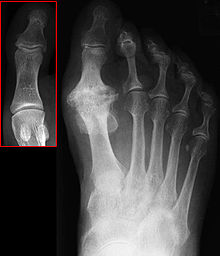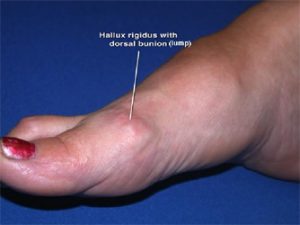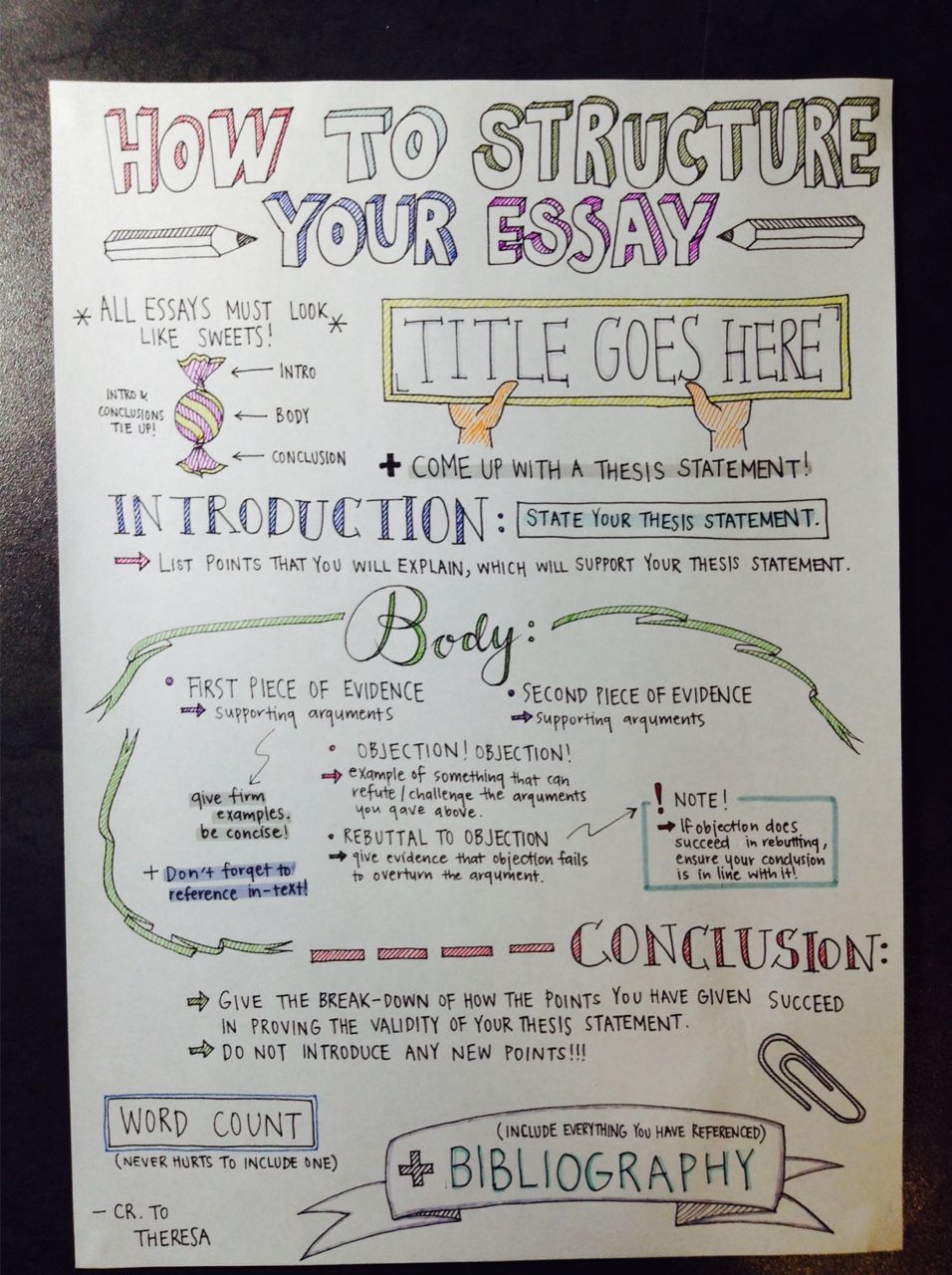
Hallux rigidus (arthritis of the big toe)
Hallux rigidus (arthritis of the big toe)
Some questions answered
What is hallux rigidus?
Hallux rigidus is arthritis of the main joint of the big toe in the ball of the foot. It is a wearing out of the joint surfaces. It is called “hallux rigidus” because its main feature is stiffness (“rigidus”) of the big toe (“hallux”).
Sometimes only the upper part of the joint is affected and the rest of the joint is undamaged. In other people the whole joint is worn out.
What causes it?
In most people there is no definite cause – it just develops. Probably the main reason why this joint is particularly subject to wearing out is that it is under tremendous stress in walking. With each step, a force equal to twice your body weight passes through this very small joint.
In a few people it may be caused by an injury or another medical problem such as gout or an infection in the joint. There are a lot of theories about why the joint becomes arthritic but as yet none of them seem very helpful in treatment or prevention of the condition.
What problems does it cause?
The commonest problem is pain in the big toe joint. In some people the pain is present whenever they walk or even at rest, but in others it only occurs when they turn the big toe up as far as it will go.
Stiffness is also a common problem. The ability to turn the big toe upwards is lost, although it can usually be turned downwards. Sometimes it gets so stiff it points downwards and cannot be laid flat on the floor.
A bony bump (“osteophyte” or “dorsal bunion”) may develop on top of the joint. This is your body’s natural response to the worn joint. The bump may rub on the shoes. In some people this is their only problem.


Because of the painful big toe some people tend to walk on the side of the foot. This may produce pain in the ball of the foot or down its outside border. The wear and tear of the joint reduces the joint space as seen in the picture.( Inset shows normal joint space)
Sometimes the joint wears down more on the outer side, towards the lesser toes, than on the inner side. This may make the toe tilt towards the second toe, and the toes may rub together.
Why have I got this condition in my twenties?
It is well known that hallux rigidus may begin early in life, even in the teens. The reason is unknown.
Fortunately, the chances are that your toe will not get progressively worse, and (apart from your other toe) you are not much more likely to get arthritis in other joints, such as your hips and knees, than anyone else.
What will happen – will I be crippled by this condition?
Research shows that although the joint remains arthritic and stiff, it tends not to get much worse in the majority of people. Even after 20 years the joint was much the same as it had been when the people who were studied first went to the doctor.
However, in about 20-25% the joint becomes progressively more stiff or painful and treatment may be required.
Is there anything I can do to stop it getting worse?
- Keep yourself generally fit and active
- Wear shoes that comfortably fit your feet.
- Don’t get overweight.
– all the usual advice for good health in fact! There is nothing else that reliably helps.
What can be done about hallux rigidus?
You can take simple pain killers for the pain if it is bad and interfering with your life. Try paracetamol first as side-effects are rare at the correct dosage. If this does not work your doctor may prescribe stronger pain killers or anti-inflammatory medicines if these are considered to be safe for you.
Because the joint is usually most painful when the toe is bent upwards during walking, it sometimes helps to stiffen the sole of your shoe so that it does not bend while walking. If you do this, you may need a small “rocker bar” on the sole of your shoe so that you can rock over this while walking instead of bending your toe up. This can be done for you by an orthotist or chiropodist. One disadvantage of this treatment is that the stiff insole may push your osteophyte up against the shoe.
If the toe remains very painful, it may be worth injecting some steroid mixed with local anaesthetic into the joint. This reduces the inflammation inside the joint. The injection can usually be given in the outpatient clinic, although sometimes you may have to come into hospital as a day patient. The toe may be painful for a few days after the injection and any improvement has usually occurred by a week. If your toe is improved by an injection the effect may last for a few days, weeks or months. Occasionally the improvement can be permanent.
Can an operation help?
If none of the above treatments help, an operation will be helpful. Depending on the arthritic changes various surgeries can be planned and it is best decided by the foot and ankle surgeon.
If only the upper part of the joint is involved, the upper part of the joint can be trimmed out and the joint washed out. This operation is called a cheilectomy. Most people who have a cheilectomy get less pain and a useful improvement. In about 75% this improvement is permanent. The others develop worsening of the arthritis over the following years and some will eventually need another operation.
Either as a separate operation or at the same time as a cheilectomy, the bone in the base of your great toe (proximal phalanx) may be reshaped to make the most of the movement you have left.
If the whole joint is involved, then fusion of the joint should be considered.
In young fit people, especially those doing heavy jobs, a fusion of the joint would be recommended. This removes the painful joint and stiffens it completely. 95% of people will get rid of their pain. However, the toe is stiffer than before and the choice of shoes is more limited. A few people will go on to get arthritis of the small joint in the middle of the toe after a fusion, but this is not usually troublesome.
ALSO READ


How To Choose The Ideal Paper Writing Service
Posted On 24 May 2023
When you use a paper writing service, then you are picking a company that's devoted to your needs. They are…
APA Live Chat – The Way I Could Write My Paper?
Posted On 8 May 2023
If you've got a big test coming up and you need to have it done on time, and then you…
How to Write My Paper Cheaply
Posted On 7 May 2023
There are many ways to compose my paper inexpensively. In fact, some approaches can actually save money for the writer.…
Posted On 4 May 2023
Have Fun and Enjoy a Fun Way to Enjoy your time at home by playing free slots at the casino…
How to Write My Essay About Writing Sample Papers
Posted On 23 Apr 2023
Are you worried about how to write my own article? I understand, it's somewhat intimidating when you first begin learning…

College Application Essay Writing Service Voucher Reddit.com
Posted On 12 Apr 2023
This will suggest having a apparent being familiar with of the supply material or the subject and sticking shut to…

Quality Custom Essay Writing Service Reddit.com
Posted On 12 Apr 2023
Many universities present distinctive deals with savings which you could uncover fascinating. This way you will hardly ever free the…
Reddit Custom Essay Writing Service For Cheap
Posted On 12 Apr 2023
The Looming Questions: Will the reserve be a accomplishment or not? How considerably would this maximize your composing money? Now,…
Reddit Essay Writing Service Atlanta Ga
Posted On 11 Apr 2023
Pretty much as vital as firm any time you are producing essays, is concept generation. Nothing at all will kill…
Reddit.com Persuasive Essay Writing Service Online
Posted On 11 Apr 2023
As aspect of the organizing for faculty admissions, a timeline ought to be established in progress. Consequently, your site visitors…